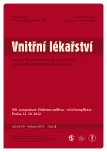-
Medical journals
- Career
Incretin therapy and diabetic retinopathy
Published in: Vnitř Lék 2013; 59(3): 204-207
Category: Reviews
Overview
Therapy based on incretins presents a new group of medicinal substances designated for an intervention in patients with type 2 diabetes. It includes a therapy that is efficient, safe and effective. Its advantage is a low risk of hypoglycaemia and a positive effect on body weight. The analyses that have been published so far consistently indicate a positive impact on cardiovascular risk factors. The first studies conducted on animal models prove a favourable influence of incretin therapy on the pathophysiology of diabetic retinopathy.
Key words:
diabetes mellitus type 2 – gliptins – GLP-1 receptor agonists – diabetic retinopathy
Sources
1. Ahrén B. Gut peptides and Type 2 diabetes mellitus treatment. Curr Diab Rep 2003; 3 : 365–372.
2. D’Alessio DA, Vahl TP. Glucagon-like peptid 1: evolution of an incretin into a treatment for diabetes. Am J Physiol Endocrinol Metab 2004; 286: E882–E890.
3. De Meester I et al. Natural substrate of dipeptydyl petpidase IV. Adv Exp Med Biol 2000; 477 : 67–87.
4. Nauck MA et al. Efficacy and safety of the dipeptidylpeptidase-4 inhibitor, sitagliptin, compared with the sulfonylurea, glipizide, in patients with type 2 diabetes inadequately controlled on metformin alone. a randomized, double-blind, non-inferiority trial. Diabetes Obes Metab 2007; 9 : 194–205.
5. Amori RE et al. Efficacy and Safety of Incretin Therapy in Type 2 Diabetes: Systematic Review and Meta-analysis. JAMA 2007; 298 : 194–206.
6. Deacon CF. Dipeptidyl peptidase-4 inhibitors in the treatment of type 2 diabetes: a comparative review. Diabetes Obes Metab 2011; 13 : 7–18.
7. Fakhoury WK, Lereun C, Wright D. A meta--analysis of placebo-controlled clinical trials assessing the efficacy and safety of incretin-based medications in patients with type 2 diabetes. Pharmacology 2010; 86 : 44–57.
8. Topp GP et al. Differences in Reported Efficacy between Oral Anti-Hyperglycemic Agents Largely Reflect Differences in Baseline A1C. Diabetes 2008; 1: (suppl. 1): A436–A437.
9. Migoya EM et al. Dipeptidyl peptidase-4 inhibitors administered in combination with metformin result in an additive increase in the plasma concentration of active GLP-1. Clin Pharmacol Ther 2010; 88 : 801–808.
10. Goldstein BJ et al. Effect of Initial Combination Therapy With Sitagliptin, a Dipeptidyl Peptidase-4 Inhibitor, and Metformin on Glycemic Control in Patiens With Type 2 Diabetes. Diabetes Care 2007; 30 : 1979–1987.
11. Monami M, Marchionni N, Mannucci E. Glucagon-like peptide-1 receptor agonists in type 2 diabetes: a meta-analysis of randomized clinical trials. Eur J Endocrinol 2009; 160 : 909–917.
12. Pratley RE. Overview of glucagon-like peptide-1 analogs and dipeptidyl peptidase-4 inhibitors for type 2 diabetes. Medscape J Med 2008; 28 : 171.
13. Vilsbøll T et al. Liraglutide, a once-daily human GLP-1 analogue, improves pancreatic B-cell function and arginine-stimulated insulin secretion during hyperglycaemia in patients with Type 2 diabetes mellitus. Diabet Med 2008; 25 : 152–156.
14. Fineman M, Flanagan S, Taylor K et al. Pharmacokinetics and pharmacodynamics of exenatide extended-release after single and multiple dosing. Clin Pharmacokinet 2011; 50 : 65–74.
15. DeYoung MB, MacConell L, Sarin V et al. Encapsulation of exenatide in poly-(D,L-lactide-co-glycolide) microspheres produced an investigational long-acting once-weekly formulation for type 2 diabetes. Diabetes Technol Ther 201; 13 : 1145–1154.
16. Murphy CE. Review of the safety and efficacy of exenatide once weekly for the treatment of type 2 diabetes mellitus. Ann Pharmacother 2012; 46 : 812–821.
17. Scott LJ. Exenatide extended-release: a review of its use in type 2 diabetes mellitus. Drugs 2012; 72 : 1679–1707.
18. Zhang R, Zhang H, Xu L et al. Neuroprotective effect of intravitreal cell-based glucagon-like peptide-1 production in the optic nerve crush model. Acta Ophthalmol 2011; 89: e320–e326.
19. Zhang Y, Zhang J, Wang Q et al. Intravitreal injection of exendin-4 analogue protects retinal cells in early diabetic rats. Invest Ophthalmol Vis Sci 2011; 52 : 278–285.
20. Zhang Y, Wang Q, Zhang J et al. Protection of exendin-4 analogue in early experimental diabetic retinopathy. Graefes Arch Clin Exp Ophthalmol 2009; 247 : 699–706.
21. Gonçalves A, Leal E, Paiva A et al. Protective effects of the dipeptidyl peptidase IV inhibitor sitagliptin in the blood-retinal barrier in a type 2 diabetes animal model. Diabetes Obes Metab 2012; 14 : 454–463.
Labels
Diabetology Endocrinology Internal medicine
Article was published inInternal Medicine

2013 Issue 3-
All articles in this issue
- What has the largest study in the history of diabetology brought us?
- Changes in weight and diabetes compensation (HbA1c) in patients with diabetes mellitus type 2 after adding exenatide (Byetta) to the current treatment in 28 diabetology departments in the Czech Republic – BIBY-I study (observations lasting 3 to 12 months)
- Patophysiology of diabetic retinopathy
- Risk factors for diabetic retinopathy
- Present state of diagnostic and screening of the diabetic retinopathy and diabetic macular oedema
- The benefit of pars plana vitrectomy for the resolution of complications of proliferative diabetic retinopathy
- Treatment of diabetic macular oedema
- Diabetic nephropathy/diabetic kidney disease
- Incretin therapy and diabetic retinopathy
- Present and future of insulin treatment
- Diabetic retinopathy in the Czech National Diabetes Programme 2012–2022
- Problematic issues related to screening for diabetic retinopathy
- Progression of diabetic retinopathy in pregnancy
- Diabetic macular oedema in the third trimester of pregnancy
- Treatment of diabetic macular oedema in a type 1 diabetes patient – mistakes in interdisciplinary collaboration
- Internal Medicine
- Journal archive
- Current issue
- Online only
- About the journal
Most read in this issue- Diabetic nephropathy/diabetic kidney disease
- Treatment of diabetic macular oedema
- Progression of diabetic retinopathy in pregnancy
- Patophysiology of diabetic retinopathy
Login#ADS_BOTTOM_SCRIPTS#Forgotten passwordEnter the email address that you registered with. We will send you instructions on how to set a new password.
- Career

